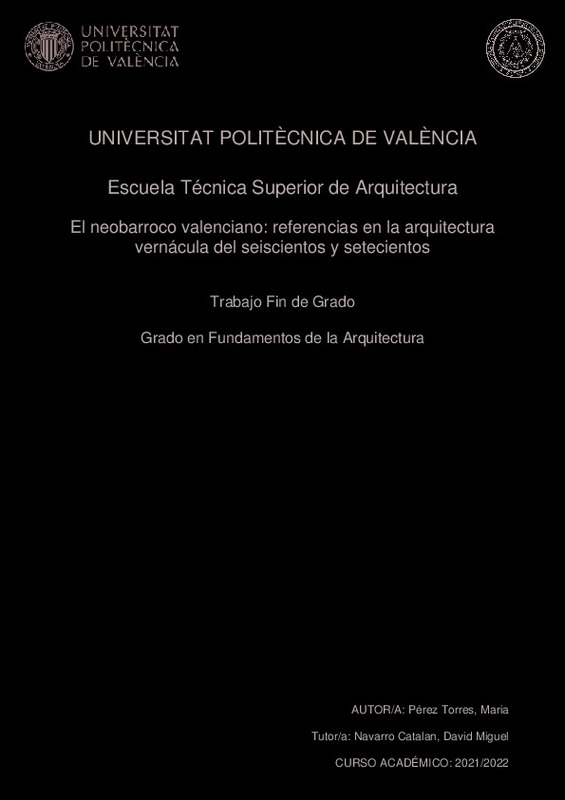JavaScript is disabled for your browser. Some features of this site may not work without it.
Buscar en RiuNet
Listar
Mi cuenta
Estadísticas
Ayuda RiuNet
Admin. UPV
El neobarroco valenciano: referencias en la arquitectura vernácula del seiscientos y setecientos
Mostrar el registro sencillo del ítem
Ficheros en el ítem
| dc.contributor.advisor | Navarro Catalan, David Miguel
|
es_ES |
| dc.contributor.author | Pérez Torres, María
|
es_ES |
| dc.date.accessioned | 2022-11-16T10:44:53Z | |
| dc.date.available | 2022-11-16T10:44:53Z | |
| dc.date.created | 2022-09-30 | |
| dc.date.issued | 2022-11-16 | es_ES |
| dc.identifier.uri | http://hdl.handle.net/10251/189791 | |
| dc.description.abstract | [ES] El Movimiento Moderno es sin duda la corriente que marca la arquitectura de inicios del siglo XX debido a la gran repercusión que tuvo a nivel internacional. Pero en paralelo a este, especialmente en el periodo comprendido entre las décadas del 1910 y el 1950, se desarrollaron arquitecturas que pretendían rescatar modelos del pasado, debido a la necesidad de encontrar una arquitectura que realmente se adaptara al contexto en el que se encuentra. Es aquí donde el neobarroco se gesta como estilo arquitectónico, surge de la respuesta a una arquitectura del Movimiento Moderno que no acaba de arraigarse y de la búsqueda de un estilo que se adapte a los avances del momento pero sin olvidarse de la tradición constructiva. En Valencia, esta corriente es la que caracteriza la imagen de la ciudad que tenemos a día de hoy. Mediante este Trabajo de Fin de Grado se pretende analizar de forma detallada los edificios que representan el estilo neobarroco dentro de la ciudad, tanto en su contexto urbanístico como histórico, para así poder relacionarlas con las referencias tomadas de los grandes ejemplos de edificios barrocos para así poder aportar y reivindicar el respaldo teórico con el que cuentan estas arquitecturas. | es_ES |
| dc.description.abstract | [EN] The Modern Movement is undoubtedly the current that marks the architecture of the early twentieth century due to the great impact it had internationally. But in parallel to this, especially in the period between the decades of 1910 and 1950, architectures were developed that sought to rescue models of the past, due to the need to find an architecture that really adapted to the context in which it is located. It is here where the neo-Baroque is gestated as an architectural style, arises from the response to an architecture of the Modern Movement that does not just take root and the search for a style that adapts to the advances of the moment but without forgetting the constructive tradition. In Valencia, this current is the one that characterizes the image of the city we have today. This Final Degree Project aims to analyze in detail the buildings that represent the neo-baroque style in the city, both in its urban and historical context, in order to relate them to the references taken from the great examples of baroque buildings and thus be able to provide and claim the theoretical support that these architectures have. | es_ES |
| dc.format.extent | 93 | es_ES |
| dc.language | Español | es_ES |
| dc.publisher | Universitat Politècnica de València | es_ES |
| dc.rights | Reserva de todos los derechos | es_ES |
| dc.subject | Arquitectura neobarroca | es_ES |
| dc.subject | Antonio Gómez Davó | es_ES |
| dc.subject | Arquitectura Valenciana | es_ES |
| dc.subject | Regionalismo | es_ES |
| dc.subject | Portadas | es_ES |
| dc.subject | Ornamentación | es_ES |
| dc.subject | Siglo XX | es_ES |
| dc.subject | Neo-baroque architecture | es_ES |
| dc.subject | Valencian architecture | es_ES |
| dc.subject | Regionalism | es_ES |
| dc.subject | Front doors | es_ES |
| dc.subject | Ornamentation | es_ES |
| dc.subject | 20th century | es_ES |
| dc.subject.classification | COMPOSICION ARQUITECTONICA | es_ES |
| dc.subject.other | Grado en Fundamentos de la Arquitectura-Grau en Fonaments de l'Arquitectura | es_ES |
| dc.title | El neobarroco valenciano: referencias en la arquitectura vernácula del seiscientos y setecientos | es_ES |
| dc.title.alternative | Valencian neo-baroque: references in vernacular architecture of XVI and XVII century | es_ES |
| dc.title.alternative | El neobarroc valencià: referències en l'arquitectura vernàcula dels segles XVII i XVIII | es_ES |
| dc.type | Proyecto/Trabajo fin de carrera/grado | es_ES |
| dc.rights.accessRights | Abierto | es_ES |
| dc.contributor.affiliation | Universitat Politècnica de València. Departamento de Composición Arquitectónica - Departament de Composició Arquitectònica | es_ES |
| dc.contributor.affiliation | Universitat Politècnica de València. Escuela Técnica Superior de Arquitectura - Escola Tècnica Superior d'Arquitectura | es_ES |
| dc.description.bibliographicCitation | Pérez Torres, M. (2022). El neobarroco valenciano: referencias en la arquitectura vernácula del seiscientos y setecientos. Universitat Politècnica de València. http://hdl.handle.net/10251/189791 | es_ES |
| dc.description.accrualMethod | TFGM | es_ES |
| dc.relation.pasarela | TFGM\146636 | es_ES |
Este ítem aparece en la(s) siguiente(s) colección(ones)
-
ETSA - Trabajos académicos [4687]
Escuela Técnica Superior de Arquitectura






